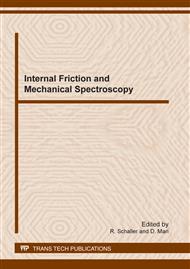p.372
p.378
p.387
p.393
p.399
p.405
p.411
p.416
p.422
Mechanical Spectroscopy, a Tool to Characterize Cement Latex Composites
Abstract:
Fair dispersion of polymer and control of component grain size are key properties to achieve high performances building material (i.e. ultra high strength concrete, self-levelling floor, or exterior insulation composite system). As microstructure analysis in an organic/inorganic hydrated co-matrix material is time consuming, mechanical spectroscopy temperature analysis could characterise both the polymer and the hydrates in the same run. The temperature dependence of the storage modulus G’ and the loss modulus G’’ of some composite building material was therefore measured between 173 and 470 K by mechanical spectroscopy (Dynamic Mechanical Analysis). A model material was then defined to enable DMA latex/cement interaction study. The latex was reinforced by either a microfiller (OMYA limestone) or a microfiller and a nanofiller (hydrated Lafarge cement paste CEM I 52.5 R). The latex evaluated in this study was a 210nm styrene butyl acrylate (SBA). The measurements confirmed that polymer environment was not hindered by micro or nanofiller (i.e. cement). The hydrated cement paste transformation onset was measured at 373K, but occurred at higher temperature as latex content increased. ESEM micrographs performed during heating have proven that within the hydrated cement paste many parallel cracks propagated at once, while within SBA hydrated cement paste no cracks were observed. The hydrated cement microstructure was modified by SBA, and became less sensitive to temperature increase due to SBA latex ability to deform.
Info:
Periodical:
Pages:
399-404
Citation:
Online since:
January 2012
Authors:
Keywords:
Price:
Сopyright:
© 2012 Trans Tech Publications Ltd. All Rights Reserved
Share:
Citation:


